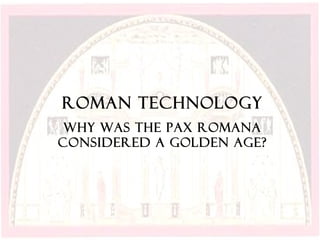
Roman technology-q
- 1. Roman Technology Why was the pax romana considered a golden age?
- 2. The pax romana – or roman peace began with the reign of augustus caesar and lasted for 200 years. During this time, the Romans made great strides in technology and infrastructure. Roman technology can be found today from north Africa to England.
- 4. Roman Architecture The Pantheon is a circular building with a great concrete dome rising from the walls and with a front porch of Corinthian columns supporting a gabled roof with a triangular pediment. The Pantheon is remarkable for its size, its construction, and its design. The dome was the largest built until modern times, measuring about 142 feet in diameter and rising to a height of 71 feet above its base. There is no external evidence of brick arch support inside the dome, except in the lowest part, and the exact method of construction has never been determined. The Coliseum (Coloseum, Colosseum), was built during the reign of Emperor Vespasiano c. 72 AD Over 160 ft high with eighty entrances, the Coliseum could hold upwards of 50,000 spectators. Public events such as gladiator fights, mock naval battles and wild animal hunts were held at the Coliseum. During the staged fights as many as 10,000 people were killed. Fighters were slaves, prisoners or volunteers. Spectators saw persecuted Christians killed by lions.
- 5. The dome
- 6. The dome meant bigger buildings could be built which were safer and did not need thick walls or large numbers of pillars to support the ceiling. This piece of technology will be lost to medieval Europeans.
- 11. Inside the pantheon in Rome.
- 15. Colosseums
- 16. Colosseum in nimes in France
- 17. Roman Colosseum in Croatia
- 20. Under the floor were cages and cells for animals gladiators and Christians.
- 21. Roman Roads The Romans builT many Roads ThRoughouT TheiR empiRe. The Roads made iT easieR To TRavel and TRade wiTh faRaway pRovinces. iT also made iT easieR To collecT Taxes. Roman Roads weRe sTRaighT and followed an exacT design. The expRession, “all Roads lead To Rome” RefeRs To The facT ThaT Rome was The cenTeR of modeRn civilizaTion. The Road sysTem of The ancienT Romans was one of The gReaTesT engineeRing accomplishmenTs of iTs Time, wiTh oveR 50,000 miles of paved Road RadiaTing fRom TheiR cenTeR aT The miliaRius auRem in The foRum in The ciTy of Rome.
- 22. Roman roads
- 23. Paved Roads • The roads were not completely flat • They consisted of several parts – The central and highest was the most important, it was convex to conduct the water to the – Ditches that were built in the sides
- 26. Roman Aqueducts The Romans consTRucTed numeRous aqueducTs To supply waTeR To ciTies and indusTRial siTes. The ciTy of Rome iTself had The laRgesT concenTRaTion, wiTh waTeR being supplied by eleven aqueducTs consTRucTed oveR a peRiod of 500 yeaRs. TheiR combined lengTh was neaRly 260 miles. howeveR, only 29 miles weRe above gRound, as mosT Roman aqueducTs weRe consTRucTed below The suRface. sTone "pipes" ThaT caRRied waTeR fRom ouTlying aReas To laRge ciTies. why weRe They so Tall and TilTed? They had To caRRy RainwaTeR and waTeR fRom higheR alTiTudes downwaRd To ReseRvoiRs in laRge ciTies. The picTuRes ThaT we noRmally see aRe of aqueducTs above gRound, buT mosT of Them weRe undeRgRound. They also builT public laTRines and sysTems of sewage pipes To caRRy sewage ouT of The sTReeTs and dump iT inTo The RiveR.
- 27. Water technology The civilizations we have looked at so far, have all been located near rivers. Needless to say, your largest cities and towns were located on the waterfront. The Romans developed sophisticated technology to move water over great distances. For the first time in human history people were able to live in large numbers far away from natural water sources.
- 28. Aqueducts • Aqueducts were built in order to avoid geographic irregularities between fountains or rivers and towns. • Not only valleys were crossed by superposed cannels, but also mountains were excavated by long tunnels, pits and levels of maintenance. • They were used to bring water to cities.
- 29. aqueducts
- 32. Model of Rome's main aqueducts
- 35. Civil Buildings: Baths • There were spaces for public life • They consisted of different rooms: • Changing rooms – Different temperature rooms: • Frigidarium (cold) • Tepidarium (warm) • Caldarium (hot) – Swimming pool – Gymnasium – Library
- 37. Roman baths were built all over the empire. The city of bath in England is so named because it had a large roman bath there. The Turkish baths are the direct descendents of the Roman baths. The upper classes would meet there in the afternoon to swim, relax, get a massage and conduct business.
- 39. Notice the channels under the floors used to heat the bath water.
- 40. Plumbing and sewer systems • Roman cities has indoor plumbing and sewer systems. •This allowed the Roman cities to stay very clean by ancient standards and certainly much cleaner than medieval cities in Western Europe. • People had access to fresh water for drinking and cooking and…
- 41. Most important of all, flushing toilets!!
- 42. These were public toilets and the water continually flowed underneath. The wealthy had toilets you could flush by lifting a piece of wood that blocked the sluice.
- 43. Hypothetical reconstruction of Roman Forum in Imperial times. Watercolor (18th century), Giuseppe Becchetti